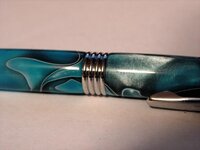JoeOCNJ
Member
Been doing a lot of acrylic, and I watched Barry Gross's video on working with acrylic. I am noticing some sanding marks even after using PSI's finishing polish.
I sand with 250g paper, then use the 6-grit system from PSI, sorry, i don't remember what grits they are.. But after im done with the highest grit, and using the one-step polish, I still have some marks on the acrylic from the finishing. No matter how careful I try to be or thorough they are still there.
Does anyone know of a buffing wheel(s) that I could use on my existing pen mandril to work on those marks. In the video Mr. Gross swears by the buffing wheel. I believe he uses a cotton and flannel wheel, with a purple color compound. Not sure what it is. He designed one for sale at PSI, and it won't help me (i don't think... unless someone know's different.. ) because it uses a #2 MT and my HF lathe is a #1MT. So I thought maybe I could buy a couple wheels and the compound and "make my own" since they tapers are different.
any suggestions are greatly appreciated
Thanks
Joe
I sand with 250g paper, then use the 6-grit system from PSI, sorry, i don't remember what grits they are.. But after im done with the highest grit, and using the one-step polish, I still have some marks on the acrylic from the finishing. No matter how careful I try to be or thorough they are still there.
Does anyone know of a buffing wheel(s) that I could use on my existing pen mandril to work on those marks. In the video Mr. Gross swears by the buffing wheel. I believe he uses a cotton and flannel wheel, with a purple color compound. Not sure what it is. He designed one for sale at PSI, and it won't help me (i don't think... unless someone know's different.. ) because it uses a #2 MT and my HF lathe is a #1MT. So I thought maybe I could buy a couple wheels and the compound and "make my own" since they tapers are different.
any suggestions are greatly appreciated
Thanks
Joe


